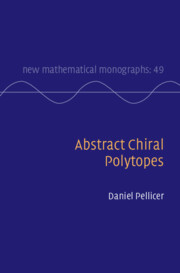Book contents
- Frontmatter
- Contents
- Preface
- 1 Introduction
- 2 Abstract Regular and Chiral Polytopes
- 3 Groups Related to Chiral Polytopes
- 4 Polytopes Constructed from Other Polytopes
- 5 Families of Chiral Polytopes
- 6 Skeletal Polytopes
- Appendix A A Few Treats on Euclidean Geometry
- Appendix B A Few Words about Numbers
- Appendix C Open Problems
- References
- Index
5 - Families of Chiral Polytopes
Published online by Cambridge University Press: 23 March 2025
- Frontmatter
- Contents
- Preface
- 1 Introduction
- 2 Abstract Regular and Chiral Polytopes
- 3 Groups Related to Chiral Polytopes
- 4 Polytopes Constructed from Other Polytopes
- 5 Families of Chiral Polytopes
- 6 Skeletal Polytopes
- Appendix A A Few Treats on Euclidean Geometry
- Appendix B A Few Words about Numbers
- Appendix C Open Problems
- References
- Index
Summary
The first part of this chapter is devoted to studying three families of chiral polytopes grouped by common properties. The first family consists of chiral polyhedra, which are chiral polytopes of the lowest possible rank. The second family groups the tight chiral polytopes, which are the natural candidates to be the chiral polytopes with the smallest number of flags in each rank where they exist (3 and 4). The third family includes chiral polytopes obtained from geometric constructions, like Coxeter’s twisted honeycombs and Roli’s cube. The second part of the chapter deals with ideas to construct chiral polytopes of high ranks, a task that since the origin of the notion of abstract chiral polytope has proved to be difficult. One of these ideas is to build a polytope of rank n+1 from a set of building blocks that are isomorphic polytopes of rank n, while keeping the vertex-figures all isomorphic to some other prescribed polytope; such a polytope of rank n+1 is said to be an amalgamation of the other two. The second idea is similar, but without prescribing the isomorphism type of the vertex-figure. The polytopes of rank n+1 constructed in this way are said to be extensions of the polytope of rank n.
Keywords
- Type
- Chapter
- Information
- Abstract Chiral Polytopes , pp. 263 - 341Publisher: Cambridge University PressPrint publication year: 2025

